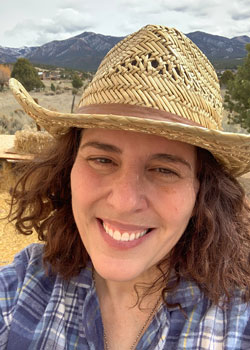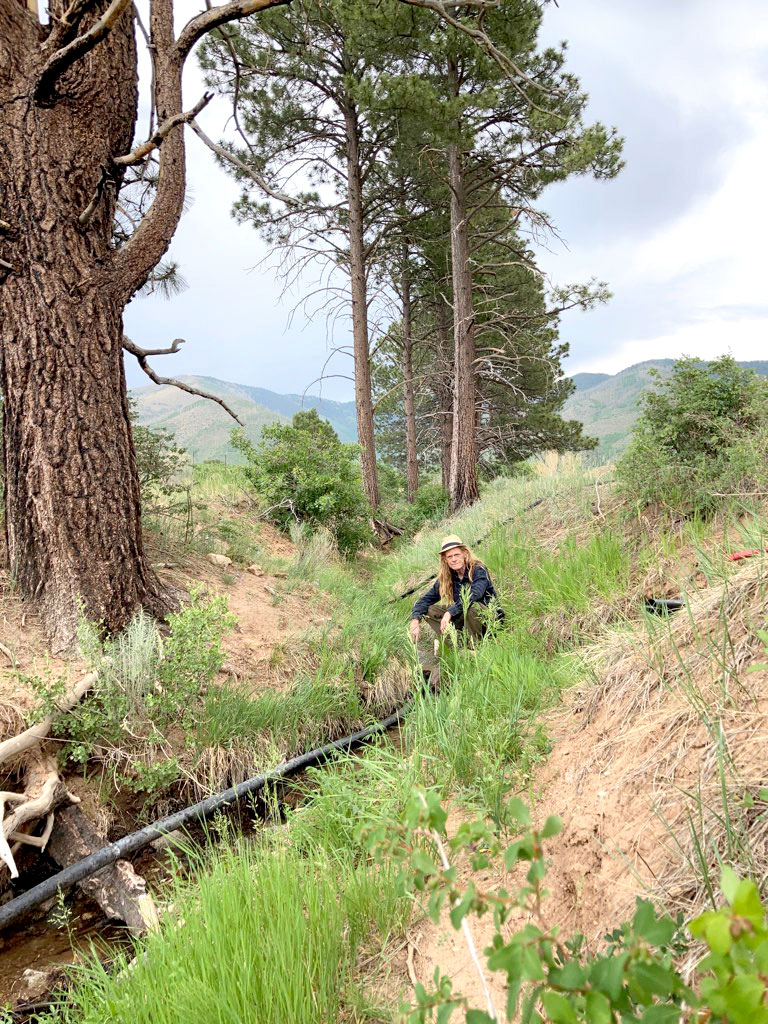By Caroline Yezer
Nat Wilson has been the Mayordomo for the El Rito de la Lama Acequia Association for a couple of decades. Born in Colorado, Nat grew up in Denver, Albuquerque, and overseas in India when his father, Bud Wilson, had a job teaching medicine. Yet his very first childhood memory is of Lama. When he was three years old, he remembers peering into the Lama sky, mesmerized by how fast the clouds zoomed past. Today, in his role as Mayordomo, Nat thinks a lot about those clouds, and what futures they hold for small highland communities like Lama.
The El Rito de la Lama acequia is just one of about 700 working ditches that deliver water from New Mexico’s mountain peaks to farms and people below. Compared to its 300-year-old (and older) siblings, the Lama ditch is a spring chicken: it was incorporated over 100 years ago, to promote agriculture and protect water rights for agricultural and domestic use.
Nat makes it clear that the Lama ditch is NOT a domestic water association. It delivers water for residential use, as well as to sustain greenhouses, gardens, orchards, pastures and hayfields. We tend to think of ditches in terms of field irrigation, but the acequia was traditionally a source for household water as well. This is still the case in communities like Lama, where successfully drilling a well and hitting water is, as Nat says, “a big gamble.” Each user is responsible for filtering or treating this household water. Stock tanks are also filled all through the year by the main pipe’s flow.
About a decade ago, during an extreme drought, Nat and the Lama community responded by installing more than a mile of inch-and-a-half poly pipe, which can deliver 30 gallons per minute, all freefalling gravity flow—it’s not a pressurized system. This has been a lifeline in times of scarcity. “We have a fantastic hybrid water delivery system on our acequia. We maintain the natural historic earthen ditch for times when we have good water flow, but we are prepared for the worst when it dries up.”
Putting the pipe along the ditch challenged Nat’s understanding of hydrodynamics and forced him to develop his knowledge through trial and error. “The pipe was rolled out on the surface, mirroring the original acequia system. People connect to it just like they open their gate on their ditch time. We also checked the angles with a level to ensure it has a constant slope, so that it self-drains.” This made it possible for a strong water flow throughout the winter, when there is less run-off and freezing temperatures. “As long as the pipe is empty at night, we have a little window during the day between late morning and an hour before sunset when we can attach the pipes and bring water to household cisterns, and then we remove it before it starts freezing… We can have temperatures below zero at night, yet run water down the pipe in the day when it warms up and the sun shines.”
As one of the lowest parciantes on the acequia, Nat has witnessed the retreat of the waters over several decades. But this scarcity is relative: “Steve Hinton told me years back, this little bit of water we have here in Lama would supply a whole village in Morocco.” Lama parciantes have had to make do with less, but these changes have worked. As Nat points out, climate change is not only about the water drying up, but extreme weather. “Gully washers” (hard downpours) and spring runoff still provide plenty of water, but “we have to catch it and keep it from running off the land. Large storage capacity is key. Cisterns in Lama have become more essential than ever.”
Storage in ponds is also very important for Lama to maintain fire safety and provide relief for disappearing wildlife: “During the Lama fire of 1996, firefighters drew on a pond for water. So, I just try to keep it from going dry. The ponds also attract a variety of wildlife. I’ve seen migrating ducks, Great Blue Heron, a Black Ibis, and last year, a bear who went in for a swim. And I hadn’t seen a bear here for years.”
Even with all these adaptations, however, Nat explains that the traditional acequia emphasis on collaboration will play the most important role in future water stewardship. “People get very anxious about water; they can feel really desperate. It highlights the importance of cooperation— if that is lacking, that’s when way more trouble arises.” So far, the Lama acequia is still flowing strong!
Author
-

Dr. Caroline Yezer is a cultural anthropologist (PhD Duke University 2007) who has taught anthropology curriculum at College of the Holy Cross and Clark University in Massachusetts.
View all posts



